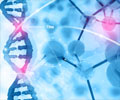PTPN11 genetic mutations in bone cells that support blood development can drive leukemia formation in nearby blood stem cells in Noonan syndrome condition.

‘Maraviroc (FDA approved drug to combat HIV infection) and BX471 (which is under development for multiple sclerosis) have shown to dampen the cancer-driving neighboring effect in patients with Noonan syndrome.’





The findings are scheduled for publication in Nature.The neighbor cell effect could be frustrating efforts to treat leukemias in Noonan syndrome patients. That's because bone marrow transplant may remove the cancerous cells, but not the cause of the problem, leading to disease recurrence. However, the researchers show that a class of drugs can dampen the cancer-driving neighbor effect in mice. One of the drugs, maraviroc, is already FDA-approved against HIV infection.
Noonan syndrome often involves short stature, distinctive facial features, congenital heart defects and bleeding problems. It occurs in between one in 1000 to one in 2500 people, and can be caused by mutations in several genes. The most common cause is mutations in the gene PTPN11. Children with Noonan syndrome are estimated to have a risk of developing leukemia or other cancers that is eight times higher than their peers.
"Our research highlights the importance of the bone marrow microenvironment," says Cheng-Kui Qu, MD, PhD, professor of pediatrics at Emory University School of Medicine, Winship Cancer Institute and Aflac Cancer and Blood Disorders Center, Children's Healthcare of Atlanta. "We found that a disease-associated mutation, which disturbs the niches where blood stem cell development occurs, can lead to leukemia formation."
Previous research had established that mutations in PTPN11 have a conventional cell-autonomous effect on blood stem cells' growth. In the current paper, researchers led by Qu show that PTPN11 mutations also affect mesenchymal stem cells, which normally nurture blood stem cells within specific niches in the bone marrow. Mesenchymal stem cells cannot become blood cells themselves.
Advertisement
"We have identified CCL3 as a potential therapeutic target for controlling leukemic progression in Noonan syndrome and for improving stem cell transplantation therapy in Noonan syndrome-associated leukemias," Qu says.
Advertisement
It turned out that their mice had also changed the PTPN11 gene in mesenchymal stem cells, but not blood stem cells. The myeloproliferative disorder in the PTPN11-mutant mice can be treated in the short term by bone marrow transplant, but it comes back within months.
The research team showed that drugs that counteract CCL3 dampen the myeloproliferative disorder in the mutant mice. One of them is maraviroc, which has been FDA-approved to combat HIV infection, and another is BX471, which was under development for multiple sclerosis. The authors caution that other Noonan syndrome mutations, in genes besides PTPN11, need to be assessed for their effects on leukemia formation.
Source-Eurekalert















